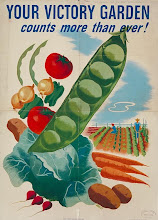

Almost before it started, the wheat harvest is nearly finished here in Big Stone County. It doesn't take long to turn a waving wheat field into a bristling lawn of wheat stalks. If you've never seen a newly harvested wheat field, you won't understand why Rumpelstiltskin spoke of turning straw into gold. It really is a true golden color. Some farmers cut the wheat stalks high, to come later and cut it again to bale straw. Most straw around here is wheat straw, although you can make straw from any stalk of grain. Other farmers just chop up the stalk in their combine and blow it out over the field.
Combines are huge. Did I say huge? I meant HUGE. A farmer friend of ours last year offered to give our eldest son a ride in one while harvesting soybeans. Owen had to climb six feet up just to get to the seats. They took four or five swaths down the field, each swatch cutting about 24 feet wide. The driver just sits in the cab, steers a bit, and watches all the various instruments telling him what's being harvested. The combine can tell you how much you're harvesting as it's doing it -- also the yield per acre, moisture levels, and a host of other things I don't even know about.
Before coming out here, I had no idea what a combine (the emphasis is on the first syllable) was, and why it had such a silly name. I think I've figured out the name. It's called a combine because it combines the tasks of what used to be done by a couple different machines. It cuts the seeds from the stalks, shells the seeds (like taking soybeans out of the pod), sorts the seed from the chaff (stuff that's not the seed), and then collects the seed in a large bin at the back of the combine.
When the bin on the combine gets full, the farmer drives over to a truck, usually a open-top semi, and the combine blows all of its seed through a large metal tube into the top of the truck. When the truck is full, the farmer drives it to the local grain elevator. Or, if he has a few large grain bins of his own, he'll bring it there to store for awhile, waiting for grain prices to get higher sometime over the winter.
A lot of what a farmer does is based on good timing. At harvest time, the seed has to have dried well on the stalk, otherwise the farmer pays more at the elevator to have it dried manually. A moist seed will rot in storage. Also, the farmer wants to sell his crop at a time when prices are high, so he can get the most money. Not to mention the timing needed at planting, when the soil has to be warm enough after winter for the seed to germinate, yet dry enough before the spring rains so his tractor doesn't get stuck in the mud.
One of the best parts (can you tell that I love this place) of living out here is being able to follow the seasons. Walking down a city street, a warm day in winter will look and feel like a cool day in summer. Out in the country, one glance at a field, a grove of trees or a farmhouse clothesline will tell you what month it is. And right here, right now, it's August; the time for harvesting wheat and for spinning straw into gold.
 The last of our crop of barn (or old granary) swallows about to leave the nest.
The last of our crop of barn (or old granary) swallows about to leave the nest.




















